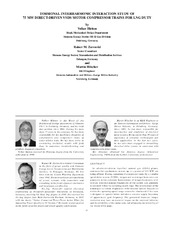| dc.description.abstract | In all-electric-driven liquefied natural gas (LNG) plants, converter-fed synchronous motors up to a power of 100 MW are being offered. During operation of compressor trains by a variable speed drive system (VSDS), integer and noninteger harmonics are generated in the converter. Intersection of integer harmonics with relevant torsional natural frequencies of the system can generally be avoided within the operating-speed range. The intersections of the noninteger excitation frequencies with torsional natural frequencies within to operating-speed range cannot be eliminated if the train is designed to operate below and above a motor supply frequency of approximate grid frequency. The generated harmonic torque excitation may have an essential impact on the torsional behavior and the reliability of the entire train and ultimately the reliability of the whole LNG plant. Due to this fact a traditional torsional analysis and specified in API 617, Seventh Edition (2002), is an obligatory task. This analysis normally considers the VSDS train operating as an individual mechanical train, including motor, coupling, and compressor, even if it is installed in a multiunit plant. As a further simplification, the torsional model does not include the full electrical/mechanical interaction.To ensure reliable operation of a 75 MW refrigerant-compressor train in an LNG plant, the effect of the full coupled electrical and mechanical VSDS train, including the electrical grid had to be investigated. In addition, with respect to torsional oscillations, two or more identical trains in parallel operation have been investigated in detail to determine the interaction. This paper details multiple issues associated with the electrical and mechanical interaction and additionally the interaction of two or more identical trains in parallel operation with respect to torsional oscillations during converter operation. The paper also provides a comparative overview of the torsional design with regard to results of the individual mechanical system, without electrical/mechanical interaction and the results of the full coupled electrical-mechanical model. The detailed analytical investigation of the behavior of the torsional system has been carried out to demonstrate the integrity of such kind of projected plant configurations of LNG duty. | en |


